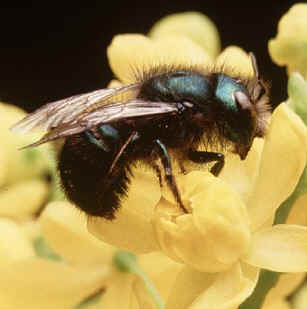![]()
Pollinator Paradise Pollination
Ecology at UI The
Solitary Bee Web
New Mexico Native Bee Pollinator Project
Bee Nests and Accessories
![]()

Sponsored by Pollinator Paradise
This announcement was published in the Edible Santa Fe magazine's Jan issue, and the Dec issue of the Santa Fe Farmers Market Dec newsletter. Pollinator Paradise supports this initiative:
Vision:
a string of farms and gardens across the New Mexico landscape with habitat that
supports both honeybees and native bee species. Our bees are facing
extraordinary threats today with problems like colony collapse & pesticide
poisonings. With the honeybees (an imported species) in jeopardy, we need to
ensure that essential pollination services continue. Without these services a
significant number of our agricultural crops would fail. There are about 4000
wild bee species in North America, some of whom help significantly with
pollination when given habitat. In New Mexico, we donít yet know all the native
species. NM bee specialists welcome more info from the field than they can
collect themselves.
Gardens for the more flamboyant hummingbirds and butterflies have become
popular; now the bees need our support. Thereís a fear factor with bees however,
even among nature lovers. Honey bees sting because they have a treasure trove to
defend, and a queen who lays all of the eggs. Not so with native species: the
vast majority of them are solitary bees who ARE VERY DOCILE and do not sting
unless they are handled roughly. When we become educated about our bees, a
new understanding develops that they can be both safe and a delight to have
around.
Potential Activities
include:
** Seed and info exchanges on
the best bee plants and cover crops for a given area
** Education about native species. They can be given nesting habitat with simple
measures---holes in wood, bundles of pithy sticks, appropriate bare ground, mud
puddles for mud builders
** Housing honeybees with simple, low cost, easily made top bar hives
** Exploring bee drinker construction to provide drinking water for bees without
drownings
** Collecting native specimens for taxonomic ID by bee specialists.
** Offering educational opportunities for all ages on the science and pleasures
of bees and bee habitat.
** A bee book club to share bee lore
** Round-robin bee garden parties and work days
Organizational possibilities
include:
a list serve; educational workshops, gatherings in membersí gardens, organized
exchange activities; lecture/demos by experts; creation and presentation of
educational projects for children'sí groups. Other ideas are welcome!. Meeting
places: participantsí gardens, supporting institutions and enterprises, a
farmerís market after vending hours, or ??
To join the
collaborative, contact:
Patty Parks-Wasserman (normal telecommunications):
patty@permacultureforchildren.net
Laurie Lange (slow track communication):
botanicarts@earthlink.net
Top of Page
![]()
Top of Page
Pollination Ecology at UI
The Solitary Bee Web
New Mexico Native Bee Pollinator Project
Bee Nests and Accessories
![]()